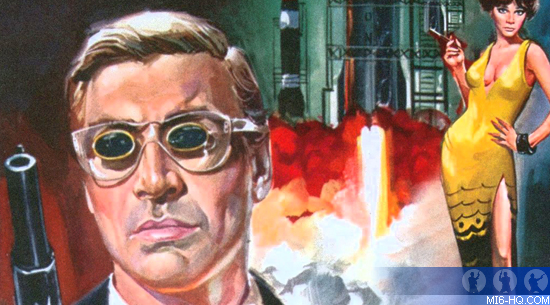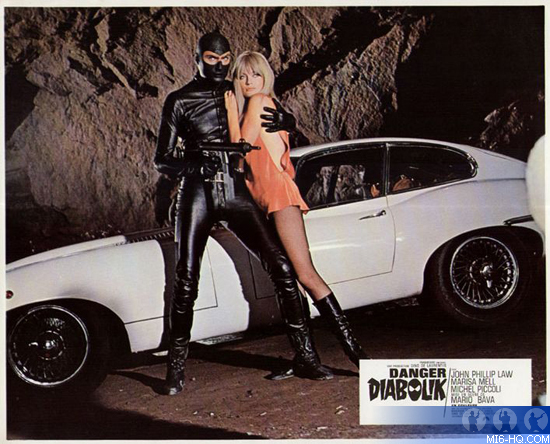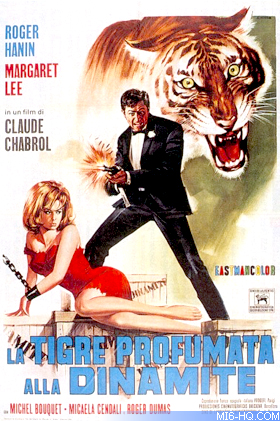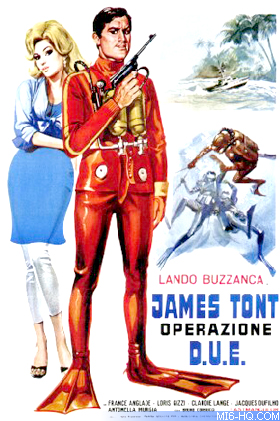Bond In The Continental Style
22nd April 2015
Benjamin Welton charts the rise and decline of the Eurospy film, the '60s spy-fi genre that followed in the wake of Bondmania
Some phenomena take a while to develop. To call them "slow starters" would be an understatement, but not inappropriate. But once lit, these cultural candles burn brightly whether or not any one is paying attention. Thus we have the origin story for the overused term "cult classic."
Other things just grab everyone's attention immediately. The James Bond films were one such instance, and almost immediately they were parodied, recycled, and reshaped. In Europe, Bond shared the silver screen with a whole host of knock-offs, from the Italian James Tont to the French super spy called The Tiger. Known collectively as Eurospy, this sub-genre of espionage films shamelessly tried to cash-in on the enormous popularity of the James Bond films in the mid-to-late 1960s. By most accounts, Europsy films never made the same amount of money or carried the cultural clout as the big budget Bond pictures. Then again, Europsy films were never real competition - they were a quick way to make a buck out of audiences who seemed to have an insatiable appetite for all things spy-related. Some Eurospy films are surprisingly good; most are pure dreck. In either case, the Eurospy genre deserves another small moment in the spotlight, especially since Bondmania wouldn't be half as fun today without it.

Before getting much further into the madcap world of Eurospy, a disclaimer: from here on out, the only films that will be counted as Eurospy will be the ones that were made in those countries comprising mainland Europe. Although many great British spy films were many during this period, and even though a large portion of these films are more or less fashioned in the James Bond style, they will be excluded for no other reason than mere geography. While I disagree with the idea that British-made spy films should never be considered Eurospy, I will cast them aside here in order to focus predominately on Italian, French, and German films.
Now, with that out of the way, let's come to 1964. The first Bond film, "Dr. No", is only two years old, but producer Albert R. "Cubby" Broccoli and a select few are already making a lifetime's worth of money because of it. All of a sudden, spies are the "it" thing and audiences who were once only turned on by dashing private eyes or the occasional G man, are now fawning over rakishly handsome secret agents in well-tailored suits that conceal foreign-made pistols and other gizmos. The Scotsman Sean Connery is the new masculine ideal, while all the products associated with Bond, from Aston Martin automobiles to Red Stripe Lager, have suddenly become must-haves.
Obviously, when something so popular takes hold so quickly with movie audiences, producers drop all pretences and become vulgar prospectors. Even in Europe, with its questionable auteur theory, the allure of James Bond and financially successful populist entertainment was hard to ignore. So, accordingly, by 1964, the Eurospy era began to take off with protagonists who either had names aurally similar to "James Bond" or who also sported the famous double-oh-seven designation. Of course, when lawyers got involved, these extra 007s went out the window in favour of other numerical sequences such as 077. Such is the price of cheap and fleeting fame.

A still from Mario Bava's 1968 feature film Danger: Diabolik
In the bigger picture, the Eurospy genre would not have been possible without Europe's economic recovery during the immediate postwar years. After the Marshall Plan dumped much-needed food, supplies, and almost $13 billion in aid, Western Europe went from a bombed out and depleted set of nations to a commercial juggernaut in record time. In West Germany, this rapid economic growth was called the Wirtschaftswunder ("economic miracle"), while in Italy the era of general prosperity became known as La Dolce Vita ("The Sweet Life"). Even in Great Britain, which won the war but suffered from the loss of empire and prestige, the 1950s and early 1960s was a time when most things went from grim to glamorous.


Given this reality, the abundant materialism of Eurospy films begins to make sense. These mass market films are stuffed full of beautiful sports cars and even more beautiful women. Frequently, Eurospy films take place either in well-known European travel destinations such as the French Riviera or the Italian island of Capri, or go international and have their action unfold against Caribbean or Asian backdrops. And like James Bond, Europsy's male protagonists gave up and coming young men fashion icons to emulate, with their sleek suits, expensive watches, and well-furnished apartments.
In essence, these films are testaments to a people grown ebullient with their newfound wealth and leisure time. Conversely, before Europe's collective leftward turn during the height of the so-called Counterculture in the late '60s, which produced a backlash against all things American, Europeans voraciously gobbled up Hollywood films and other aspects of American popular culture. The Eurospy genre therefore represents not only this consumption, but also the ways in which European producers and directors tried to repackage American and British products with Continental accents.







